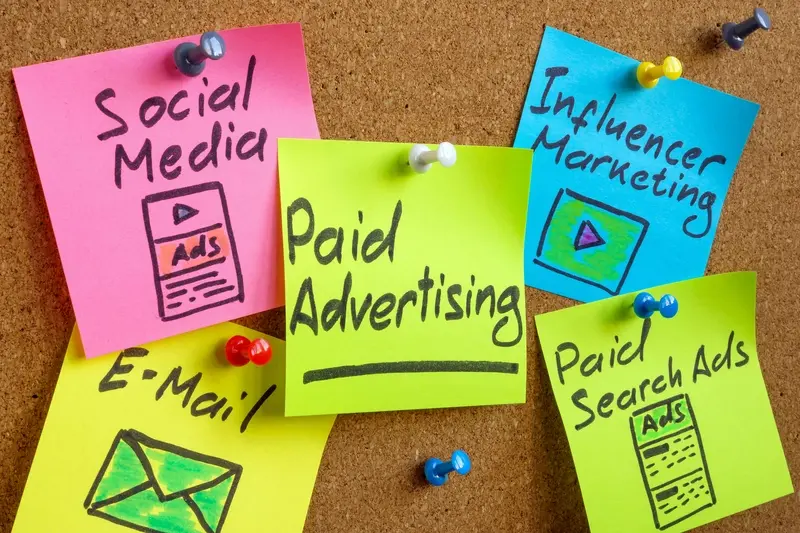What Should I Include In My Influencer Brief For App Promotion?
Most mobile app developers spend months perfecting their product, only to watch it disappear into the crowded app stores without a trace. The brutal truth? Even the best mobile app needs proper promotion to succeed—and influencer marketing has become one of the most effective ways to cut through the noise. But here's where many people trip up: they approach influencers with vague requests and wonder why their campaigns fall flat.
A well-crafted influencer brief acts as your roadmap to success. It's the difference between an influencer posting a generic "check out this app" story and creating content that genuinely connects with their audience. Without clear campaign guidelines, you're essentially asking someone to promote your app blindfolded.
The most successful app promotion campaigns start with a brief that treats influencers as creative partners, not just advertising billboards
This guide will walk you through everything you need to include in your influencer brief to maximise your app's promotional potential. We'll cover understanding your audience, setting clear goals, creating compelling content guidelines, and providing the right marketing materials. By the end, you'll have a blueprint for briefing influencers that gets results—not just empty engagement metrics.
Understanding Your Target Audience
When I'm working with clients on influencer campaigns, one of the biggest mistakes I see is treating all audiences like they're the same. They're not—and your influencer brief needs to reflect that from the start.
Before you even think about reaching out to influencers, you need to know exactly who you're trying to reach. Are you targeting busy parents who need productivity apps? Tech-savvy teenagers looking for the latest social platform? Business professionals wanting finance tools? Each group hangs out in different places online and responds to different types of content.
Defining Your Core Demographics
Your influencer brief should include specific details about your target audience so influencers can create content that actually resonates. Don't just say "young adults"—be specific about their interests, pain points, and where they spend their time online.
- Age range and gender breakdown
- Income levels and spending habits
- Interests and hobbies
- Social media platforms they use most
- Problems your app solves for them
- Language and tone preferences
Matching Influencers to Your Audience
The magic happens when an influencer's followers match your target audience perfectly. A gaming influencer with teenage followers won't work well for a retirement planning app—sounds obvious, but you'd be surprised how often this gets overlooked. Your brief should clearly state what type of influencer audience you're looking for so both parties know if it's a good fit.
Defining Clear Campaign Goals
When I'm working with clients on their mobile app marketing campaigns, one of the biggest mistakes I see is jumping straight into the creative brief without properly defining what success looks like. You wouldn't build an app without knowing what problem it solves—so why would you launch an influencer campaign without clear goals?
Your campaign goals need to be specific and measurable. "Get more downloads" isn't a goal; it's a wish. "Increase app downloads by 25% amongst fitness enthusiasts aged 25-35 within 30 days" is a proper goal that gives your influencer something concrete to work towards.
Common Campaign Goals for Mobile Apps
- Drive app downloads and installations
- Increase user engagement and retention
- Boost brand awareness in target demographics
- Generate user-generated content
- Improve app store ratings and reviews
- Promote specific features or updates
Link each goal to specific marketing materials and campaign guidelines. If you want reviews, provide influencers with clear instructions on how to request them ethically from their audience.
Your goals should align with your app's current lifecycle stage. A brand new app needs awareness and downloads, whilst an established app might focus on feature adoption or user retention. Make sure your influencer understands which stage you're at—it completely changes how they'll approach the content.
Creating Compelling Content Guidelines
Getting your content guidelines right can make or break your influencer campaign—I've seen brilliant app launches fall flat because the brief was too vague, and average apps soar because the content direction was spot on. Your influencer needs clear direction on what to create, but not so much that it stifles their creativity.
Start with the story you want told. What's the main message about your app? Is it that it saves time, makes life easier, or solves a specific problem? Give your influencer 2-3 key points to weave into their content naturally. Don't script every word; instead, provide talking points that feel authentic to their usual style.
Content Format Requirements
Be specific about what you want to see. A simple "create content about our app" won't cut it. Here's what to include:
- Video length requirements (30 seconds for TikTok, 60 seconds for Instagram Stories)
- Must-show features of your app in action
- Tone of voice—fun and casual or professional and informative
- Call-to-action placement and wording
- Hashtag requirements and branded terms
Creative Freedom vs Brand Control
Strike a balance between giving direction and allowing creativity. Influencers know their audience better than you do, so trust their instincts on delivery whilst being clear about your non-negotiables. Always request to see content before it goes live—approval processes save headaches later.
Setting Brand Standards and Requirements
Your mobile app's brand identity isn't just a logo and some colours—it's the personality that makes people remember you. When I'm working with clients on their influencer campaigns, I always stress how important it is to nail down these brand standards before any content gets created. You don't want influencers going rogue with your visual identity!
Start with the basics: your logo usage guidelines, colour palette, and fonts. Tell influencers exactly which version of your logo to use and where they can place it in their content. Some brands make the mistake of being too flexible here, then wonder why their campaign guidelines feel all over the place. Your marketing materials should look cohesive across every single post.
Voice and Tone Requirements
Beyond the visual stuff, you need to define how your brand sounds. Are you playful and casual, or professional and authoritative? Give influencers specific examples of phrases to use and—just as importantly—what to avoid saying.
Brand consistency across influencer content can increase campaign recognition by up to 80% compared to campaigns without clear guidelines
Don't forget to include your brand values and any topics that are completely off-limits. If you're promoting a fitness app, maybe you don't want influencers talking about extreme dieting. These boundaries protect your brand reputation and keep everyone on the same page.
Providing Technical Specifications
Right, let's talk about the technical bits—because nothing kills an influencer campaign faster than someone trying to showcase your app and it simply won't work on their phone. I've seen this happen more times than I care to count, and it's always painful to watch.
Your influencer brief needs to include clear technical requirements so creators know exactly what they're working with. Start with device compatibility—which operating systems does your app support? Is it iOS only, Android only, or both? What are the minimum versions required? Don't assume everyone has the latest iPhone; plenty of people are still rocking older devices.
App Store Information
You'll want to provide direct links to your app in both the App Store and Google Play Store if applicable. Make this easy for influencers to find and download. Include your app's exact name—spelling matters here because there might be similar apps out there.
Setup Requirements
Does your app require account creation? Special permissions? Location access? Let influencers know upfront so they can prepare accordingly. If there are any particular features you want them to demonstrate, mention the steps needed to access them.
- Minimum iOS/Android version requirements
- Device storage space needed
- Internet connection requirements
- Special permissions needed (camera, location, etc.)
- Account setup process
- Any premium features or subscription requirements
Being upfront about technical requirements saves everyone time and prevents awkward situations where content can't be created properly.
Establishing Performance Metrics
Right, let's talk about something that makes or breaks influencer campaigns—knowing whether they actually worked! I've seen too many brands throw money at influencers without having a clue how to measure success. It's like shooting arrows in the dark and hoping you hit something.
Your influencer brief needs to spell out exactly what you want to track. For mobile app promotion, the obvious ones are app downloads and user sign-ups, but don't stop there. You'll want to monitor engagement rates on their posts, click-through rates from their marketing materials, and how many people actually stick around after downloading your app. These metrics tell the real story.
Set up unique promo codes or tracking links for each influencer—this makes it dead simple to see who's driving the best results and helps you make smarter decisions for future campaigns.
What Numbers Actually Matter
Include specific targets in your campaign guidelines. Instead of saying "we want lots of downloads," say "we're aiming for 500 downloads within 48 hours of your post going live." This gives influencers something concrete to work towards and helps you judge whether the partnership was worth it.
Remember to track both immediate results and longer-term user behaviour—someone who downloads your app but deletes it the next day isn't nearly as valuable as someone who becomes a regular user.
Legal Considerations and Compliance
I've worked with enough brands over the years to know that legal stuff isn't the most exciting part of influencer marketing—but it's absolutely necessary. Getting this wrong can cost you thousands in fines or worse, damage your app's reputation before it even launches.
The golden rule here is disclosure. Influencers must clearly tell their audience when content is sponsored or when they've received payment or free products. This isn't just good practice; it's the law in most countries. The ASA in the UK and FTC in America take this seriously, and they regularly fine brands and creators who don't comply.
What Your Brief Should Include
Your influencer brief needs to spell out exactly how disclosure should happen. Don't assume they know the rules—many don't! Include specific hashtags like #ad or #sponsored, and make sure they understand these need to be prominent, not buried at the bottom of a long caption.
- Clear disclosure requirements (#ad, #sponsored, #gifted)
- Placement guidelines (beginning of captions, not hidden)
- Platform-specific rules (Instagram stories need clear labels)
- Your brand's content approval process
- Data protection requirements if collecting user information
Remember to include clauses about content ownership, usage rights, and what happens if they don't follow the guidelines. Trust me, having these conversations upfront saves headaches later.
Conclusion
Creating an effective influencer brief for your mobile app promotion doesn't have to be complicated—but it does need to be thorough. I've seen countless campaigns fail because the brief was too vague or missed key details that would have made all the difference. When you cover all the bases we've discussed, you're setting both yourself and your influencer up for success.
The best briefs I've worked with always include clear campaign guidelines that leave no room for confusion. They specify exactly what the influencer should showcase about the app, how they should present it, and what messaging resonates with the target audience. Don't forget to include all your marketing materials—screenshots, app store links, key features, and any promotional assets they might need.
Your brief should feel like a helpful roadmap rather than a rigid rulebook. Give influencers the creative freedom to work in their own style whilst ensuring they hit your key objectives. Remember, they know their audience better than anyone, so trust their expertise whilst providing the structure they need to represent your mobile app authentically. A well-crafted brief is your foundation for campaigns that actually drive downloads and engagement.
Share this
Subscribe To Our Learning Centre
You May Also Like
These Related Guides

How Do I Segment My Email List for Better App Marketing Results?

How Do I Measure If My App Influencer Campaign Actually Worked?



